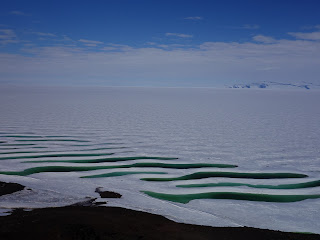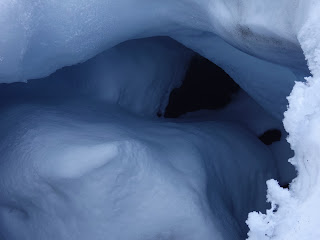1/2/19
I’ve been trying to get up to Erebus for some time now. For
my environmental work I needed to go up to test the water at Lower Erebus Hut
(LEH) to make sure the filter up there is working since the snow up there is
high in lead, fluoride, and various acids due to the proximity of the camp to
the active volcano. For SAR we were planning to go up to Erebus to practice
high altitude rescue on a steep slope. For those who don’t know, Mount Erebus
is the giant smoking volcano that shares Ross Island with us. It’s about 12,400
feet, rising straight from the ocean, and has one of the only permanent lava
lakes in the world. Permanent lava lakes are becoming fewer these day as Erta
Ale’s (Ethiopia) lava lake disappeared a year and a half ago and both Benbow
and Ambrym (Vanuatu) lava lakes disappeared last December. Currently the only
long-lasting permanent lava lake remaining, other than Erebus, is in the Congo.
However, Masaya in Nicaragua has had a lava lake in its crater for the last 5
or so year.
The previous week we had geared up all our SAR gear 3 times
to heat up to Erebus, but it had cancelled every time due to weather. For
collecting water samples, we actually tried one day (12/30) and made it in the
helicopter all the way up to LEH, but were unable to land. The weather wasn’t
the best, but the main issue was that there was no wind and it was cold. In
conditions like this, the helicopter creates contrails (ice crystals) that
don’t blow away with no wind, then the rotors cause the newly formed fog to
engulf the helicopter so that the pilot can’t see to land. So we basically had
a free scenic flight up there. Our pilot took us up over the crater, which was
pretty cool, though it was really hard to see much b/c Erebus was really
puffing.
Well, today was the big day! SAR would be trying for the
last time, and I was able to work out a schedule with helo ops to leave me up
on Erebus after SAR to do the water sampling. Bright and early in the morning,
the weather was beautiful, so the SAR team headed up. We landed at ConeZ, which
is a ridge where we have a lot of communication towers. Our mission was to
lower and then raise a dummy patient down and up a steep slope using anchors
and rigging. ConeZ sits at about 11,700ft, and when we got there, it felt like
summer! It was so warm and no wind. Completely different than we expected. My
role was to be the litter attendant, so I had the cool job of being lowered and
raised with the litter giving patient care and making sure the litter movements
went smoothly. Our SAR lead, Loomy, wanted us to due to the practice on
supplemental oxygen due to the high altitude and in order to test how much
oxygen would be needed in the event we had to do a high altitude rescue—despite
the supplemental O’s, a couple people still got altitude sickness (AMS). I,
however, felt fine, which was good b/c I would need to be up there several more
hours for my Environmental work without oxygen.
The views from the top were amazing! You could see other
islands, the open ocean, the Royal Society Range, the dry valleys, hut point
peninsula (where McMurdo sits), the icebreaker (it had just arrived to the ice
edge), the Erebus Glacier Tongue stretching out into McMurdo sound, Mt.
Discovery, Minna Bluff, and more! It was a fun exercise for me as I donned my
climbing harness, built a chest harness, put on crampons and a helmet, put on
my supplemental oxygen, and then was lowered down a steep pitch of snow (that
looked like an awesome chute to ski!), and then raised back up.
After the mission, I was picked up by a helo pilot to take
me to LEH. I was able to convince him to fly over the crater. This time, I got
a really great view into the smoking crater and could see where the lava lake
was (though it wasn’t glowing as it was so bright out) as he flew rather low and
close and there wasn’t too much steam. I then was dropped off at LEH to do the
water sampling. LEH sits at about 11,300ft on a more moderate slope below the
summit crater.
I was lucky b/c my helicopter ride back was delayed by quite
a bit, so I got to do some walking around. I first visited the downed
helicopter. It “crashed” (actually just was unable to take off) back in the
60’s. No one was hurt or injured, but the wind did blow it over. Camp occupants
since then have put a skeleton inside as a joke. After visiting the helicopter,
I checked out 3 of the nearby fumaroles. These are really awesome and unique to
Erebus. Hot steam coming out of vents from the volcano quickly freeze creating
stalagmite type fumaroles. This hot steam coming out of the vents also creates
pretty cool and complex ice caves. In the older and wilder days of McMurdo
(early 2000s), you could go into the caves, which were pretty awesome b/c they
were warm like a sauna and are illuminated in the cool blue hues created by
ice. They’ve found some really unique microorganisms living in the caves, so
they’ve stopped letting people go in without a permit and a Tyvek suit (The
upcoming season of National Geographic’s, One Strange Rock will feature these
caves as they were able to get a permit to film inside this year).
The caves create a hazardous feature across the landscape,
as the weight of a person could cause a roof collapse in weaker areas, so you
have to be careful as you walk around, mainly sticking to the rocks. The rocks
are cool b/c they are filled with Erebus crystals (an anorthoclase feldspar
mineral). Erebus crystals are only found here on Mt. Erebus and on Mt Kenya as
they require a certain chemical make-up of the magma and probably specific heat
and convection currents in the lava lake to create the crystals.
After some more exploring of the nearby area, the helicopter
came. I was traveling down with 2 friends (Salava and Aurora), and we were able
to again convince the pilot to fly over the crater. This pilot flew much higher
over the crater, giving us a really excellent bird’s eye view of the crater. We
stopped at Cape Royds on the way back to McM, so I was able to see (from the
helo) the large adelie penguin rookery and Shackleton’s historic hut on Cape
Royds.
 |
| cool melt pools on the ob hill loop trail |
 |
| approaching erebus in the helo |
 |
| looking at ConeZ ridge |
 |
| ConeZ ridge |
 |
| erebus crystal |
 |
| Erebus glacier tongue and hut point peninsula in the distance shrouded in fog |
 |
| me geared up with Oxygen |
 |
| me and the litter being lowered |
 |
| Erebus Crater |
 |
| Lower Erebus Hut (LEH) |
 |
| Downed helicopter |
 |
| fumarole ice cave. Heat was coming outo f them |
 |
| fumarole |
 |
| LEH and Oxygen supply |
 |
| Erebus crater |
 |
| me with the litter and "vicitim" |
 |
| me being lowered down with the litter and vicitm |
 |
| rigging team |
 |
| our sar team |
 |
| me and a couple others gearing up |






























































No comments:
Post a Comment